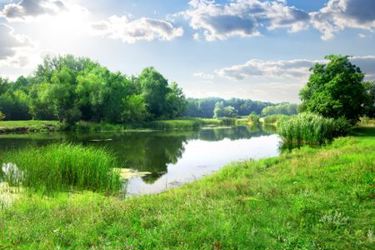Houston's Exploration Green Prevents Flooding With Detention Ponds
By Briana Hilton

Houston’s Exploration Green — recognized as one of the best examples of green infrastructure in the United States — is an impressive flood retention project. Spanning 200 acres and consisting of public greenspace, a nature preserve, and a series of five natural-looking retention ponds, Exploration Green cost $43 million to construct. The ponds are designed to hold some level of water permanently, while also being able to take in stormwater during surges. In total, the ponds can hold half a billion gallons of water — meaning they’re able to prevent around 2,000 homes from flooding during storms.
Flood Control, The Natural Way
Each of the five ponds are able to hold as much as 100 million gallons of floodwater during storms. Once capacity is reached, the floodwater will seep into the bayous. “The whole design of the retention ponds is to slow down the flow of water so you don’t get that surge of water hitting the local bayous,” said David Sharp, chairman of the Exploration Green Conservancy. The ponds also play an important ecological role during dry spells by supporting native animal and plant life — along with thousands of native trees and at least 200 native plant species in the surrounding land. “Nature has an amazing ability to be able to store, slow, and soak water into the ground,” said Danielle Goshen, policy specialist at the Texas Coast and Water Program of the National Wildlife Federation. “With nature-based solutions, the ecosystem is the infrastructure — whether that’s through preserving a big tract of land or recreating nature in an urban environment, like with Exploration Green.”
Saving Homes And Communities
Exploration Green Conservancy partnered with the Clear Lake City Water Authority on the project. Upon the advice of a consultant hired to help tackle worsening flooding in Clear Lake, the first detention pond was completed back in 2017 — just in time for hurricane Harvey. And, fortunately, it worked like a charm. The pond took the surge of stormwater and is estimated to have saved around 150 homes from flooding (a calculation based on insurance claims filed during past local flood events). Clear Lake resident Beverly DeMoss was all too familiar with flooding in the past; her home was damaged in 2015 after flooding from a storm seeped under the carpet. During Harvey, however, her house remained dry. As such, DeMoss couldn’t thank John Branch (president of the water authority’s Board of Directors) enough. When she saw him at church just after Harvey, she “went up and hugged him and said ‘John, you saved my house,’” DeMoss tells Houston Public Media.
Flood prevention is also particularly important for business owners. Damage from flooding results in billions of dollars of damage in the U.S. every year, with businesses collectively losing around 3.1 million days of operation alone in 2022. Landscaping and planting can play an important role in flood preparedness for businesses. For instance, lawns should be able to drain properly. An effective drainage system prevents lawns becoming waterlogged, damaged, and affected by algae.
Improving Water Quality
Preventing floods with green infrastructure also benefits water quality — which is a particular concern in urban areas. When it rains, a host of nasty pollutants, such as pesticides, bacteria, oil, fertilizers, and other chemicals make their way through storm drains and ditches, and ultimately end up in the waterways, including Galveston Bay. In response, Harris County Flood Control is now working on building floating wetlands inside the detention ponds. In addition to retaining extra water — around 1-1.5 million gallons of water per acre of wetland — wetlands also effectively filter out pollutants and improve water quality. As Mary Anne Piacentini, president of the Coastal Prairie Conservancy says, “wetlands are called nature’s kidneys for a reason.”
“Because we are on the frontlines of climate change, we have to really think innovatively and work with nature in this way,” Ayanna Jolivet Mccloud, the Executive Director of Bayou City Waterkeeper, comments on the Exploration Green. Fortunately, green infrastructure is a simple way to prevent floods, improve water and air quality, and create healthy habitats for both humans and wildlife alike.
